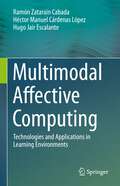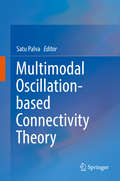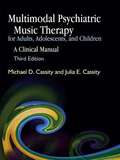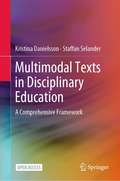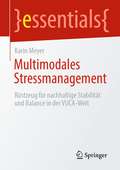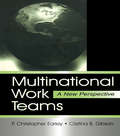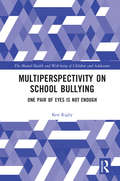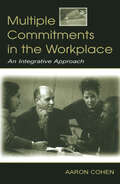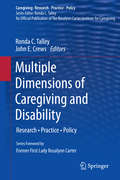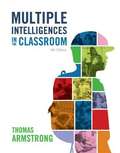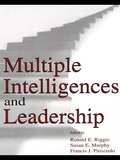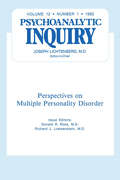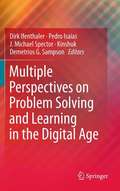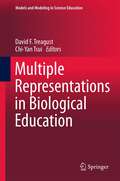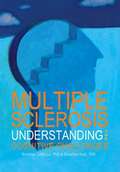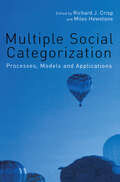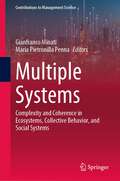- Table View
- List View
Multimodal Affective Computing: Technologies and Applications in Learning Environments
by Hugo Jair Escalante Ramón Zatarain Cabada Héctor Manuel LópezThis book explores AI methodologies for the implementation of affective states in intelligent learning environments. Divided into four parts, Multimodal Affective Computing: Technologies and Applications in Learning Environments begins with an overview of Affective Computing and Intelligent Learning Environments, from their fundamentals and essential theoretical support up to their fusion and some successful practical applications. The basic concepts of Affective Computing, Machine Learning, and Pattern Recognition in Affective Computing, and Affective Learning Environments are presented in a comprehensive and easy-to-read manner. In the second part, a review on the emerging field of Sentiment Analysis for Learning Environments is introduced, including a systematic descriptive tour through topics such as building resources for sentiment detection, methods for data representation, designing and testing the classification models, and model integration into a learning system. The methodologies corresponding to Multimodal Recognition of Learning-Oriented Emotions are presented in the third part of the book, where topics such as building resources for emotion detection, methods for data representation, multimodal recognition systems, and multimodal emotion recognition in learning environments are presented. The fourth and last part of the book is devoted to a wide application field of the combination of methodologies, such as Automatic Personality Recognition, dealing with issues such as building resources for personality recognition, methods for data representation, personality recognition models, and multimodal personality recognition for affective computing. This book can be very useful not only for beginners who are interested in affective computing and intelligent learning environments, but also for advanced and experts in the practice and developments of the field. It complies an end-to-end treatment on these subjects, especially with educational applications, making it easy for researchers and students to get on track with fundamentals, established methodologies, conventional evaluation protocols, and the latest progress on these subjects.
Multimodal Interaction Technologies for Training Affective Social Skills
by Satoshi NakamuraThis book focuses on how interactive, multimodal technology such as virtual agents can be used in training and treatment (social skills training, cognitive behavioral therapy). People with socio-affective deficits have difficulties controlling their social behavior and also suffer from interpreting others’ social behavior. Behavioral training, such as social skills training, is used in clinical settings. Patients are trained by a coach to experience social interaction and reduce social stress. In addition to behavioral training, cognitive behavioral therapy is also useful for understanding better and training social-affective interaction. All these methods are effective but expensive and difficult to access. This book describes how multimodal interactive technology can be used in healthcare for measuring and training social-affective interactions. Sensing technology analyzes users’ behaviors and eye-gaze, and various machine learning methods can be used for prediction tasks. This bookfocuses on analyzing human behaviors and implementing training methods (e.g., by virtual agents, virtual reality, dialogue modeling, personalized feedback, and evaluations). Target populations include depression, schizophrenia, autism spectrum disorder, and a much larger group of social pathological phenomena.
Multimodal Oscillation-based Connectivity Theory
by Satu PalvaSystems-level neuronal mechanisms that coordinate the temporally, anatomically, and functionally distributed neuronal activity into coherent cognitive operations in the human brain have remained poorly understood. In humans, neuronal oscillations and synchronization can be recorded non-invasively with electro- and magnetoencephalography (EEG and MEG) that have excellent temporal resolution and an adequate spatial resolution when combined with source-reconstruction methods. In this book, leading authors in the field describe how recent methodological advances have paved the way to several major breakthroughs in the observations of large-scale synchrony from human non-invasive MEG data. This volume also presents the caveats influencing analyses of synchronization. These include the non-homogeneous sensitivity of MEG to superficial cortical sources, and, most importantly, the multitude of consequences of linear mixing. Linear mixing is an immense confounder in the sensor-level analyses of synchronization, but is also present at the source level. Approaches that can be used to avoid or compensate for these issues are then discussed. Thereafter, several authors take up a number of the functional roles that large-scale synchronization has in cognition. The authors assess how the spatio-temporal and -spectral organization and strength of both local and large-scale synchronized networks are associated with conscious sensory perception, visual working memory functions, and attention. These chapters summarize several lines of research showing how the strength of local and inter-areal oscillations in both cortical and subcortical brain structures is correlated with cognitive functions. Together these data suggest that synchronized neuronal oscillations may be a systems-level neuronal mechanism underlying the coordination of distributed processing in human cognition. In line with this argument, other authors go on to describe how oscillations and synchronization are altered in clinical populations, complementing the data presented on healthy subjects. Importantly, this book includes chapters from authors using many different approaches to the analyses of neuronal oscillations, ranging from local oscillatory activities to the usage of graph theoretical tools in the analyses of synchronization. In this way the present volume provides a comprehensive view on the analyses and functional significance of neuronal oscillations in humans. This book is aimed at doctoral and post-doctoral students as well as research scientists in the fields of cognitive neuroscience, psychology, medicine, and neurosciences.
Multimodal Psychiatric Music Therapy for Adults, Adolescents and Children: A Clinical Manual (3rd Edition)
by Michael D. Cassity Julia E. CassityThis manual is a step-by-step guide to practical psychiatric music therapy, outlining a range of the most successful music therapy techniques, according to a survey of leading professionals, for a variety of clinical issues and age ranges. The manual uses helpful case studies to illustrate how assessments are made and treatments are chosen, and the appendices provide useful clinical forms and questionnaires for therapists to use with patients.
Multimodal Texts in Disciplinary Education: A Comprehensive Framework
by Kristina Danielsson Staffan SelanderThis open access book provides an introduction to multimodality and the role of multimodal texts in today’s education. Presenting a comprehensive framework for analysing and working with multimodal texts in disciplinary education, it serves as a tool for researchers and teachers alike. The second part of the book focuses on sample analyses of a variety of educational texts for different age groups and from different disciplines, including games and online resources. The authors also comment on the specific challenges of each text, and how teachers can discuss such texts with their students to enhance both their understanding of the content and their multimodal literacy. The book is intended for researchers in fields like education and multimodal studies, and for teacher educators, regardless of school subject or age group. With the combined perspectives on text analysis and implications for education, the book addresses the needs of teachers who want to work with multimodal aspects of texts in education in informed ways, but lack the right tools for such work.
Multimodal Treatment of Acute Psychiatric Illness: A Guide for Hospital Diversion
by Glendon Moriarty Justin SimpsonThe multimodal treatment of acute psychiatric illness involves a set of integrated, systematic interventions that stabilize individuals with severe mental illness and help them avoid unnecessary psychiatric hospitalization. This volume focuses on those suffering from schizophrenia, schizoaffective disorder, bipolar disorder, major depressive disorder, severe anxiety, and substance dependence, and provides individual practitioners and professional teams with the tools for responding to crisis and delivering acute care. The authors bolster the text with real-world case examples, helpful diagrams, and printable worksheets.
Multimodales Stressmanagement: Rüstzeug für nachhaltige Stabilität und Balance in der VUCA-Welt (essentials)
by Karin MeyerDie VUCA-Welt präsentiert sich als komplex, mehrdeutig, unsicher und volatil. In diesem Umfeld der Arbeit 4.0 sind Kenntnisse der eigenen Stärken und Schwächen gefragt – ebenso Kompetenzen zur Stressbewältigung. Dieser Essential gibt wesentliche Einblicke in die Relevanz und Grundlagen des multimodalen Stressmanagements in dynamischen Zeiten, in denen es auch gilt, für Zusatzbelastungen beispielsweise im Rahmen einer Pandemie gerüstet zu sein. Es werden Handlungsempfehlungen im Überblick abgebildet – mit dem Ziel, Impulse und Anregungen für die Praxis zu bieten und zur Selbstreflexion anzuleiten.
Multinational Work Teams: A New Perspective (Organization and Management Series)
by P. Christopher Earley Cristina B. GibsonThis authored book's purpose is to extend and consolidate the evolving literature on multinational work teams by developing a comprehensive theory that incorporates a dynamic, multilevel view of such teams. The model used by the authors focuses on various features of the team's members, their interactions as a team, and the organizational context in which they operate. The concept of integration and differentiation, as well as the notion of equilibrium are used as a general force guiding the specific processes that link various levels of analysis in the model. Providing a framework for scholars and students in the field of organizational studies, this book presents: *a comprehensive review of the literature related to multinational and multicultural teams; *an overview of the specific model driving our thinking along with an extensive description of the component parts; *the individual and group-level elements of teams and their members; *the linking processes that connect various elements and structures; *the catalysts that give rise to changes in various elements and structures described in the theory section; and *a general integration of the model and an application of this framework for understanding MNT's in diverse cultural contexts.
Multiperspectivity on School Bullying: One Pair of Eyes is Not Enough (The Mental Health and Well-being of Children and Adolescents)
by Ken RigbyMultiperspectivity on School Bullying is unique in providing a comprehensive account of school bullying from the perspectives of schools, teachers, parents, students and institutional authorities. It identifies diverse viewpoints and discusses their implications for addressing bullying and thereby improving the mental health and well-being of children. Drawing on findings from studies conducted in a wide range of countries, including those undertaken by the author in his own country, Australia, this book examines experiences of bullying and debates around how bullying can be best understood, managed and discouraged. It outlines what is needed before an agreed understanding of the problem can be reached and more effective anti-bullying programs devised and implemented. The book examines both historical and cultural factors relating to bullying and violence; major theoretical and research perspectives on bullying; views of different social groups affected by bullying; and how different institutional authorities view school bullying. It highlights the need for a multiperspectivity approach to bullying, taking into account and evaluating a variety of viewpoints that are currently held. This book will be of great interest to academics, researchers and students in the fields of bullying, wellbeing and mental health in schools. It will also be valuable reading for educational leaders around the globe.
Multiple Autisms: Spectrums of Advocacy and Genomic Science
by Jennifer S. SinghIs there a gene for autism? Despite a billion-dollar, twenty-year effort to find out—and the more elusive the answer, the greater the search seems to become—no single autism gene has been identified. In Multiple Autisms, Jennifer S. Singh sets out to discover how autism emerged as a genetic disorder and how this affects those who study autism and those who live with it. This is the first sustained analysis of the practices, politics, and meaning of autism genetics from a scientific, cultural, and social perspective.In 2004, when Singh began her research, the prevalence of autism was reported as 1 in 150 children. Ten years later, the number had jumped to 1 in 100, with the disorder five times more common in boys than in girls. Meanwhile the diagnosis changed to &“autistic spectrum disorders,&” and investigations began to focus more on genomics than genetics, less on single genes than on hundreds of interacting genes. Multiple Autisms charts this shift and its consequences through nine years of ethnographic observations, analysis of scientific and related literatures, and morethan seventy interviews with autism scientists, parents of children with autism, and people on the autism spectrum. The book maps out the social history of parental activism in autism genetics, the scientific optimism about finding a gene for autism and the subsequent failure, and the cost in personal and social terms of viewing and translating autism through a genomic lens.How is genetic information useful to people living with autism? By considering this question alongside the scientific and social issues that autism research raises, Singh&’s work shows us the true reach and implications of a genomic gaze.
Multiple Case Study Analysis
by Robert E. StakeExamining situational complexity is a vital part of social and behavioral science research. This engaging text provides an effective process for studying multiple cases--such as sets of teachers, staff development sessions, or clinics operating in different locations--within one complex program. The process also can be used to investigate broadly occurring phenomena without programmatic links, such as leadership or sibling rivalry. Readers learn to design, analyze, and report studies that balance common issues across the group of cases with the unique features and context of each case. Three actual case reports from a transnational early childhood program illustrate the author's approach, and helpful reproducible worksheets facilitate multicase recording and analysis.
Multiple Classifier Systems
by Friedhelm Schwenker Fabio Roli Josef KittlerThis book constitutes the refereed proceedings of the 12th International Workshop on Multiple Classifier Systems, MCS 2015, held in Günzburg, Germany, in June/July 2015. The 19 revised papers presented were carefully reviewed and selected from 25 submissions. The papers address issues in multiple classifier systems and ensemble methods, including pattern recognition, machine learning, neural network, data mining and statistics. They are organized in topical sections on theory and algorithms and application and evaluation.
Multiple Commitments in the Workplace: An Integrative Approach (Applied Psychology Series)
by Aaron CohenThe growing interest in multiple commitments among researchers and practitioners is evinced by the greater attention in the literature to the broader concept of work commitment. This includes specific objects of commitment, such as organization, work group, occupation, the union, and one's job. In the last several years a sizable body of research has accumulated on the multidimensional approach to commitment. This knowledge needs to be marshaled, its strengths highlighted, and its importance, as well as some of its weaknesses made known, with the aim of guiding future research on commitment based on a multidimensional approach. This book's purpose is to summarize this knowledge, as well as to suggest ideas and directions for future research. Most of the book addresses what seems to be the important aspects of commitment by a multidimensional approach: the differences among these forms, the definition and boundaries of commitment foci as part of a multidimensional approach, their interrelationships, and their effect on outcomes, mainly work outcomes. Two chapters concern aspects rarely examined--the relationship of commitment foci to aspects of nonwork domains and cross-cultural aspects of commitment foci--that should be important topics for future research. Addressing innovative focuses of multiple commitments at work, this book: *suggests a provocative and innovative approach on how to conceptualize and understand multiple commitments in the workplace; *provides a thorough and updated review of the existing research on multiple commitments; *analyzes the relationships among commitment forms and how they might affect behavior at work; and *covers topics rarely covered in multiple commitment research and includes all common scales of commitment forms that can assist researchers and practitioners in measuring commitment forms.
Multiple Dimensions of Caregiving and Disability
by John E. Crews Ronda C. TalleyCaring for people with disabilities often becomes an all-encompassing responsibility for one or more family members. To manage the multifaceted demands, caregivers must possess strong multitasking skills, including the ability to assist with daily life tasks; provide emotional support; help with financial affairs; mediate and advocate with health care providers. Maintaining balance within their own lives can become incredibly challenging for caregivers. More often than not, providing care for family members or loved ones occurs at the expense of the caregivers' well-being. And for caregivers who themselves have disabilities, it further complicates matters. Multiple Dimensions of Caregiving and Disability addresses concerns that have been long familiar to the caregiver population and examines the current state of family care for individuals with disabilities. With a lifespan perspective, this concise reference reviews the literature on specific problems of caregivers and explores which care strategies are effective, promising, or lacking in available resources and support interventions. Contributors also explore the more fluid and subjective aspects of caregiving, such as feelings, spirituality, and family roles. Suggestions for future policy improvements, particularly within the public health sector, are discussed as well. Topics covered include: * Family dynamics and caregiving for people with disabilities. * Parent caregiving of children with disabilities. * Race, ethnicity, socioeconomic status, and caregiving. * Educational, training, and support programs for caregivers. * Emerging technologies to aid caregivers. * Developing partnerships between caregivers and health care providers. Multiple Dimensions of Caregiving and Disability is a must-have resource for researchers, scientist-practitioners, policy makers, and graduate students across such disciplines as clinical psychology, nursing, social work, public health, medicine, and social and education policy.
Multiple Family Therapy: The Marlborough Model and Its Wider Applications (The Systemic Thinking and Practice Series)
by Salvador Minuchin Neil Dawson Brenda McHugh Eia Asen Alan CooklinIf a troubled family contains the resources to solve its own problems, then why not bring such families together, to share their experiences and support each other? This is the approach of the Marlborough Family Service, the institution at the forefront of development for child-protection cases, school-based interventions and family therapy for ethnic-minority communities for over twenty years. In this book three long-standing staff members describe for the first time their innovative work with a range of family problems, from marital violence and child abuse to educational problems and eating disorders.
Multiple Intelligences In The Classroom (Fourth Edition)
by Thomas ArmstrongIt provides educators at all levels with everything they need to apply MI theory to curriculum development, lesson planning, assessment, special education, cognitive skills, career development, educational policy, and more.
Multiple Intelligences and Leadership (Organization and Management Series)
by Susan E. Murphy Ronald E. Riggio Francis J. PirozzoloThis edited book presents cutting-edge research looking at the role of multiple intelligence--cognitive (IQ), emotional intelligence, social intelligence--in effective leadership, written by the most distinguished scholars in the two distinct fields of intelligence and leadership. The synergy of bringing together both traditional intelligence researchers and renowned leadership scholars to discuss how multiple forms of intelligence impact leadership has important implications for the study and the practice of organizational and political leadership. This volume emanates from the recent explosion of interest in non-IQ domains of intelligence, particularly in Emotional Intelligence and Social Intelligence. Indeed, the leading EI and SI scholars have contributed to this book. Research described in this book suggests that: (1) possession of multiple forms of intelligence is important for effective leadership; (2) researchers are just beginning to understand the breadth, depth, and potential applications of non-IQ domains of intelligence; (3) incorporating multiple intelligence constructs into existing leadership theories will improve our understanding of effective leadership; and (4) research on multiple intelligence has important implications for both the selection and training of future leaders.
Multiple Personality Disorder: Psychoanalytic Inquiry, 12.1
by Donald R. Ross Richard J. LoewensteinFirst published in 1992. The Volume 12, number 1 1992 of Psychoanalytic Inquiry offer viewpoints in a collection of articles on Multiple Personality Disorder which evolved from a symposium on 21st April 1990.
Multiple Perspectives on Problem Solving and Learning in the Digital Age
by Dirk Ifenthaler J. Michael Spector Kinshuk Pedro Isaias Demetrios G. SampsonThis edited volume with selected expanded papers from CELDA (Cognition and Exploratory Learning in the Digital Age) 2009 (http://www.celda-conf.org/) addresses the main issues concerned with problem solving, evolving learning processes, innovative pedagogies, and technology-based educational applications in the digital age. There have been advances in both cognitive psychology and computing that have affected the educational arena. The convergence of these two disciplines is increasing at a fast pace and affecting academia and professional practice in many ways. Paradigms such as just-in-time learning, constructivism, student-centered learning and collaborative approaches have emerged and are being supported by technological advancements such as simulations, virtual reality and multi-agents systems. These developments have created both opportunities and areas of serious concerns. This volume aims to cover both technological as well as pedagogical issues related to these developments.
Multiple Relationships in Psychotherapy and Counseling: Unavoidable, Common, and Mandatory Dual Relations in Therapy
by Ofer ZurThis first-of-a-kind analysis will focus exclusively on unavoidable and mandated multiple relationships between clients and psychotherapists. The book will cover the ethics of a range of venues and situations where dual relationships are mandated, such as in the military, prisons/jails, and police departments, and settings where multiple relationships are unavoidable, such as rural communities; graduate schools and training institutions; faith, spiritual, recovery or 12-step, minority and disabled communities, total institutions, and sport psychology. The complexities of social network ethics and digital dual relationships, such as clients becoming "friends" or "fans" on their therapists’ social media pages are discussed. Finally, the book will discuss the complexities multiple roles that inevitably emerge in supervisory relationships.
Multiple Relationships in Psychotherapy and Counseling: Unavoidable, Common, and Mandatory Dual Relations in Therapy
by Ofer ZurThis first-of-a-kind analysis will focus exclusively on unavoidable and mandated multiple relationships between clients and psychotherapists. The book will cover the ethics of a range of venues and situations where dual relationships are mandated, such as in the military, prisons/jails, and police departments, and settings where multiple relationships are unavoidable, such as rural communities; graduate schools and training institutions; faith, spiritual, recovery or 12-step, minority and disabled communities, total institutions, and sport psychology. The complexities of social network ethics and digital dual relationships, such as clients becoming "friends" or "fans" on their therapists’ social media pages are discussed. Finally, the book will discuss the complexities multiple roles that inevitably emerge in supervisory relationships.
Multiple Representations in Biological Education
by David F. Treagust Chi-Yan TsuiThis new publication in the Models and Modeling in Science Education series synthesizes a wealth of international research on using multiple representations in biology education and aims for a coherent framework in using them to improve higher-order learning. Addressing a major gap in the literature, the volume proposes a theoretical model for advancing biology educators' notions of how multiple external representations (MERs) such as analogies, metaphors and visualizations can best be harnessed for improving teaching and learning in biology at all pedagogical levels. The content tackles the conceptual and linguistic difficulties of learning biology at each level--macro, micro, sub-micro, and symbolic, illustrating how MERs can be used in teaching across these levels and in various combinations, as well as in differing contexts and topic areas. The strategies outlined will help students' reasoning and problem-solving skills, enhance their ability to construct mental models and internal representations, and, ultimately, will assist in increasing public understanding of biology-related issues, a key goal in today's world of pressing concerns over societal problems about food, environment, energy, and health. The book concludes by highlighting important aspects of research in biological education in the post-genomic, information age.
Multiple Sclerosis: Understanding the Cognitive Challenges
by Nicholas Larocca Rosalind KalbWritten by two clinical psychologists with contributions from two neuropsychologists -- each an MS specialist -- Multiple Sclerosis: Understanding the Cognitive Challenges answers all questions patients may have about their condition, including: A definition of cognition and discussion of the processes that underlie human thought The emotional and social impact of cognitive changes The neuropsychological evaluation of cognitive symptoms Detailed overview of treatment options Vignettes describing the real-life experiences of people with cognitive dysfunction Extensive references to the scientific literature Combining detailed, referenced advice with hands-on strategies for living, this is the only book to provide in-depth information about cognitive dysfunction. It will be an invaluable reference to patients, families, and caregivers, as well as to health professionals who care for people with MS.
Multiple Social Categorization: Processes, Models and Applications
by Richard J. Crisp Miles Hewstone'Ethnic cleansing', 'institutional racism', and 'social exclusion' are just some of the terms used to describe one of the most pressing social issues facing today’s societies: prejudice and intergroup discrimination. Invariably, these pervasive social problems can be traced back to differences in religion, ethnicity, or countless other bases of group membership: the social categories to which people belong. Social categorization, how we classify ourselves and others, exerts a profound influence on our thoughts, beliefs, feelings, and behaviors. In this volume, Richard Crisp and Miles Hewstone bring together a selection of leading figures in the social sciences to focus on a rapidly emerging, but critically important, new question: how, when, and why do people classify others along multiple dimensions of social categorization? The volume also explores what this means for social behavior, and what implications multiple and complex perceptions of category membership might have for reducing prejudice, discrimination, and social exclusion. Topics covered include: the cognitive, motivational, and affective implications of multiple categorization the crossed categorization and common ingroup methods of reducing prejudice and intergroup discrimination the nature of social categorization among multicultural, multiethnic, and multilingual individuals. Multiple Social Categorization: Process, Models and Applications addresses issues that are central to social psychology and will be of particular interest to those studying or researching in the fields of Group Processes and Intergroup Relations.
Multiple Systems: Complexity and Coherence in Ecosystems, Collective Behavior, and Social Systems (Contributions to Management Science)
by Gianfranco Minati Maria Pietronilla PennaThis book presents the proceedings of the Eighth National Conference of the Italian Systems Society. The contributions underline the need for Systemics and Systems Science in order to address multiple, changing systems involving several coherent versions.The conference focused on identifying, discussing, and understanding possible interrelationships between fundamental theoretical advances in different disciplines. Given their scope, these proceedings represent a valuable asset for all researchers whose work involves multiple systems.
